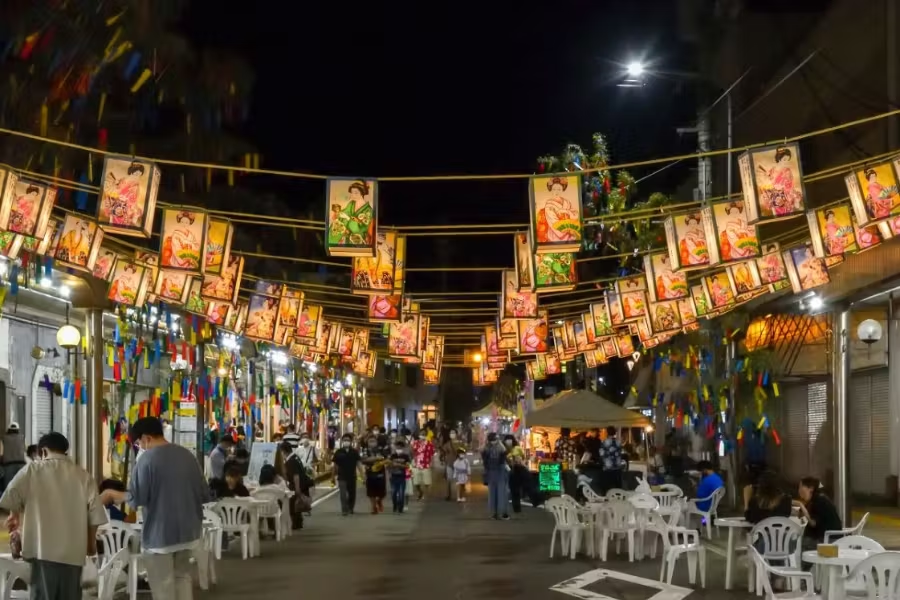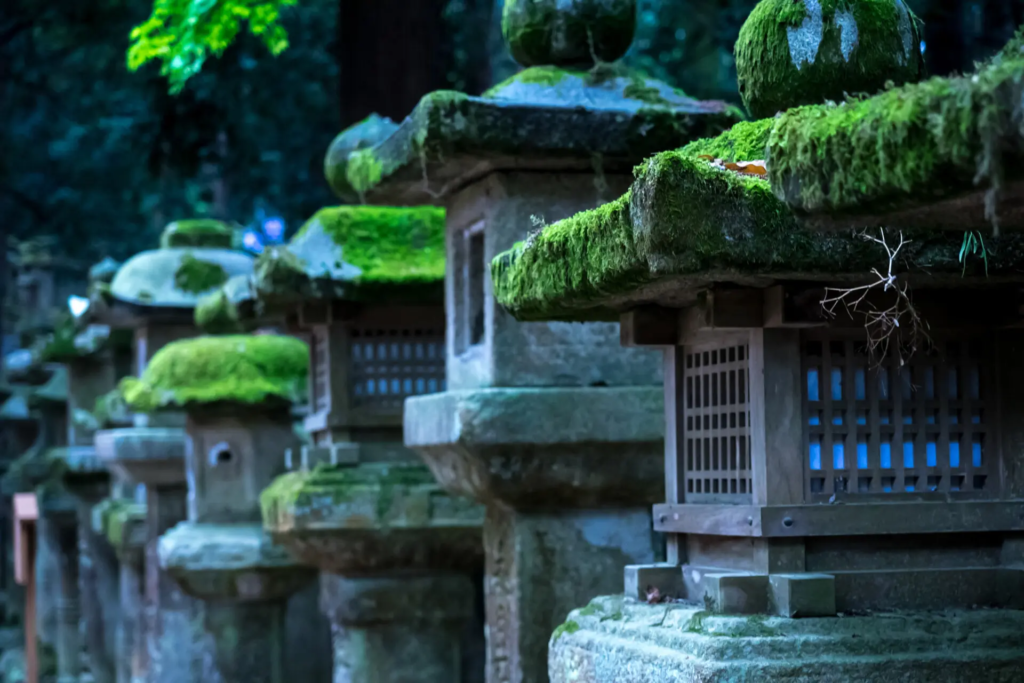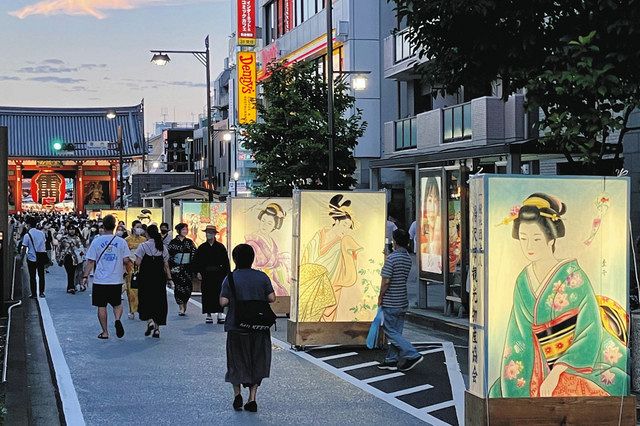How are you doing now that the peak of midsummer has passed? This summer has been particularly hot, with a great deal of rain and thunder, and there seems to have been a lot of news about the weather. However, in Japan, a country with four distinct seasons, we are accustomed to dealing with such natural phenomena. Our ancestors have a history of effectively utilizing the characteristics of the four seasons and passing them down as events. Cherry blossom viewing in the spring, autumn leaf peeping in the fall, and snow-covering in the winter…. And this time, although the climax of the season has passed, I would like to introduce summer festivals, which can be said to be a summer tradition. Wearing a yukata to dispel the lingering summer heat and exploring the stalls with a fan in hand. Dancing to the rhythm of taiko drums. It is a traditional event that creates an extraordinary space, free from daily life. I will write about the “Kaminarimon Bon Odori – Yume Doro” in the old town of Asakusa. In addition, I would like to look back on the history of the Tanabata Festival, which is the origin of this festival, as well as the history of the object and culture called “Tourou.
Kaminarimon Bon Dance – Yume Tourou
Kaminarimon Bon Odori is a festival sponsored by two local shopping streets, and this year was the eighth. The south side of Namiki-dori is the Bon Odori venue, and anyone can participate in this large-scale event, with the dancing circle spreading around the turret. Men and women of all ages gather to dance in front of the Kaminarimon, a rare opportunity to dance in front of the Kaminarimon.

Among the most impressive are the picture Tourou that decorate the streets at night. The fantastic Akita pictured Tourou are lit. And what’s more, the Kaminarimon is the only place outside of Akita where you can see “picture Tourou”.

Ukiyoe beauties glowing from within are bewitching and beautiful. The sight of these beauties lined up in a row along the street is spectacular. Detailed information on the festival is as follows.
・Place of the festival
Nearest station: Asakusa Namiki-dori Asakusa Station
Location: 2 Kaminarimon, Taito-ku, Tokyo 111-0034 MAP
Venues: Namiki-dori in front of Kaminarimon, Kaminarimon Ichinomiya Shopping District, Kaminarimon Eastern Shopping District, etc.
・Period: Saturday, September 07, 2024
*On September 6, the day before the festival, only the lottery and the display of picture Tourou will be held.
・Time: Bon dance 18:00 – 20:00, lottery 12:00 – 20:00, Tourou lighting 17:00 – 20:00
Fees and costs: Free of charge (only food and drink at food stalls are charged). (Only food and beverages at food stalls are available for a fee.)
・In case of rain: Cancelled in case of stormy weather, rain or shine
As mentioned above, picture Tourou originated in Akita Prefecture.
Tanabata Picture Tourou Festival

The Tanabata Picture Tourou Festival is said to have originated when the wife of Yoshiyasu Satake, the seventh head of the Satake Minami family of the Akita Domain, was “invited” from the Takatakasa family of Kyoto to entrust her nostalgic feelings for Kyoto to a five-color strip of paper and decorate it on green bamboo. The style of the festival evolved over time, with Tourou decorating the eaves of houses during the Meiji period (1868-1912), and large Tourou hung in every town in the Yuzawa area during the Taisho and Showa periods (1926-89), competing for beauty. The process of making a Tourou takes more than a month, including searching for a subject, drawing a rough sketch, edging the design with ink, and coloring. Once the work is completed, it is attached to a wooden frame and covered with vinyl to prevent it from getting wet in the rain and tearing. In this way, the work is carefully and painstakingly made. Unlike the Kaminarimon in Akita, where the original Tourou were made, the picture Tourou are hung from the ceiling. When the wind blows, the Tourou sway and glow in the dark, creating a fantastic atmosphere. By the way, I have written many times about “Tourou,” but what exactly are these Tourou and what are their uses? I suspect that there are many people who do not know what they are.
What is a Tourou?

Tourou” is a common sight in shrines, inns, gardens, and other prestigious Japanese-style settings, but few people today seem to know the significance of its existence and purpose. The tourou is a perfect stage set for creating a Japanese atmosphere, but what is its purpose? An overview is given below.
Tourou is a type of traditional East Asian lighting fixture, widely distributed in Japan, China, the Korean Peninsula, Vietnam, and other countries. The old Chinese character for “light” was “tou” (燈), and the variant (expanded new character) for “basket” was “籠” (籠), so there are many variant Chinese characters such as Tourou and Tourou. Originally, a basket was literally a basket of light, with a wooden frame and paper or other material used to enclose the light so that it would not be extinguished by the wind or other causes. Smaller wooden baskets are used in Shinto shrines. In addition, a solid stone tourou or metal tourou (such as copper tourou) is used in outdoor areas such as temple gardens. Tourou were introduced to Japan with the arrival of Buddhism, and became widely produced from the Nara period (710-794), when temple construction began to flourish, and were mostly used by Buddhist monks.

I am ashamed to admit that until I was an adult, I mistakenly thought that a tourou was, in other words, a stone tourou. I did not even know that it was a type of lighting. I had seen it many times when I visited shrines, inns, gardens, and other spaces. Incidentally, the reason why I did not recognize the stone tourou as lighting was because I had never encountered an actual lighted object before. The role of the stone tourou as a light has been replaced by an electric light with the development of technology. In that case, the tourou is now just a mere ornament. So until now, I have only thought of the tourou (and especially the stone tourou) as an unidentifiable and tasteful stage set-up. However, as I come into contact with various documents, I am reminded of how much Tourou is an everyday object and how indispensable it was in people’s daily lives. I also learned that the tourou was not only a utilitarian item that illuminated the darkness at night, but also an item that played a spiritual and cultural role for the people of that time. In other words, as represented by the Tourou, while playing the role of lighting, it also had a Dionysian aspect, as when it appeared at festivals with ukiyoe beauties to uplift people’s spirits.
★This blog is written by Ricky★
Leave it to us when it comes to cultural matters! Ricky, the Japanese culture evangelist, will turn you into a Japan geek!
Authority
Kaminarimon Bon Odori – Yume Tourou – [Official Website

Tanabata-e Tourou Festival – Yuzawa City Web site
Tourou Wikipedia




